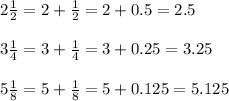Answer: A) Yes
============================================================
Step-by-step explanation:
Convert each mixed number to decimal form

We have the three potential sides of a = 2.5, b = 3.25 and c = 5.125
For a triangle to be possible with these side lengths, the following three inequalities must all be true
Which is due to the triangle inequality theorem.
In other words, we should be able to add any two sides to get a result larger than the third side.
- a+b = 2.5+3.25 = 5.75 is larger than c = 5.125, so a+b > c is true.
- a+c = 2.5+5.125 = 7.625 is larger than b = 3.25, so a+c > b is true.
- b+c = 3.25+5.125 = 8.375 is larger than a = 2.5, so b+c > a is true.
All three inequalities mentioned are true when (a,b,c) = (2.5, 3.25, 5.125)
Therefore, a triangle is possible with these side lengths.